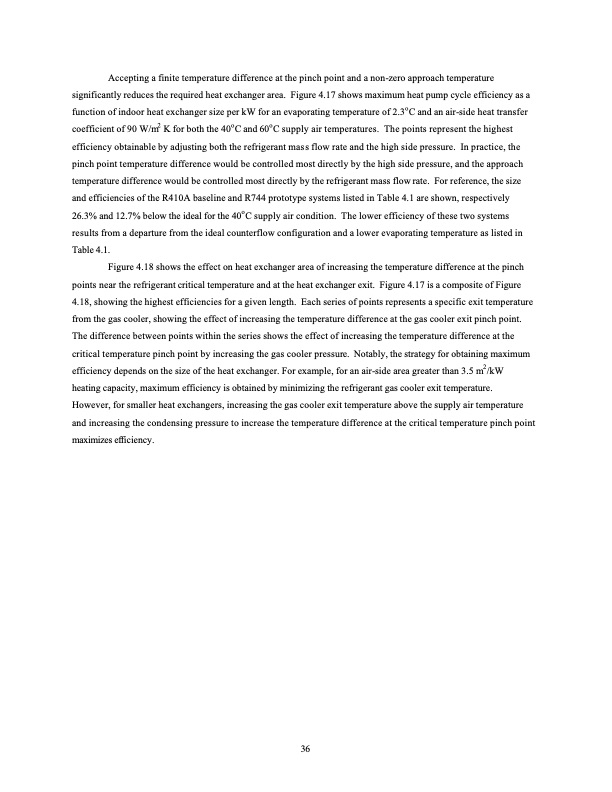
PDF Publication Title:
Text from PDF Page: 047
Accepting a finite temperature difference at the pinch point and a non-zero approach temperature significantly reduces the required heat exchanger area. Figure 4.17 shows maximum heat pump cycle efficiency as a function of indoor heat exchanger size per kW for an evaporating temperature of 2.3oC and an air-side heat transfer coefficient of 90 W/m2 K for both the 40oC and 60oC supply air temperatures. The points represent the highest efficiency obtainable by adjusting both the refrigerant mass flow rate and the high side pressure. In practice, the pinch point temperature difference would be controlled most directly by the high side pressure, and the approach temperature difference would be controlled most directly by the refrigerant mass flow rate. For reference, the size and efficiencies of the R410A baseline and R744 prototype systems listed in Table 4.1 are shown, respectively 26.3% and 12.7% below the ideal for the 40oC supply air condition. The lower efficiency of these two systems results from a departure from the ideal counterflow configuration and a lower evaporating temperature as listed in Table 4.1. Figure 4.18 shows the effect on heat exchanger area of increasing the temperature difference at the pinch points near the refrigerant critical temperature and at the heat exchanger exit. Figure 4.17 is a composite of Figure 4.18, showing the highest efficiencies for a given length. Each series of points represents a specific exit temperature from the gas cooler, showing the effect of increasing the temperature difference at the gas cooler exit pinch point. The difference between points within the series shows the effect of increasing the temperature difference at the critical temperature pinch point by increasing the gas cooler pressure. Notably, the strategy for obtaining maximum efficiency depends on the size of the heat exchanger. For example, for an air-side area greater than 3.5 m2/kW heating capacity, maximum efficiency is obtained by minimizing the refrigerant gas cooler exit temperature. However, for smaller heat exchangers, increasing the gas cooler exit temperature above the supply air temperature and increasing the condensing pressure to increase the temperature difference at the critical temperature pinch point maximizes efficiency. 36PDF Image | Comparison of R744 and R410A

PDF Search Title:
Comparison of R744 and R410AOriginal File Name Searched:
CR039.pdfDIY PDF Search: Google It | Yahoo | Bing
CO2 Organic Rankine Cycle Experimenter Platform The supercritical CO2 phase change system is both a heat pump and organic rankine cycle which can be used for those purposes and as a supercritical extractor for advanced subcritical and supercritical extraction technology. Uses include producing nanoparticles, precious metal CO2 extraction, lithium battery recycling, and other applications... More Info
Heat Pumps CO2 ORC Heat Pump System Platform More Info
| CONTACT TEL: 608-238-6001 Email: greg@infinityturbine.com | RSS | AMP |